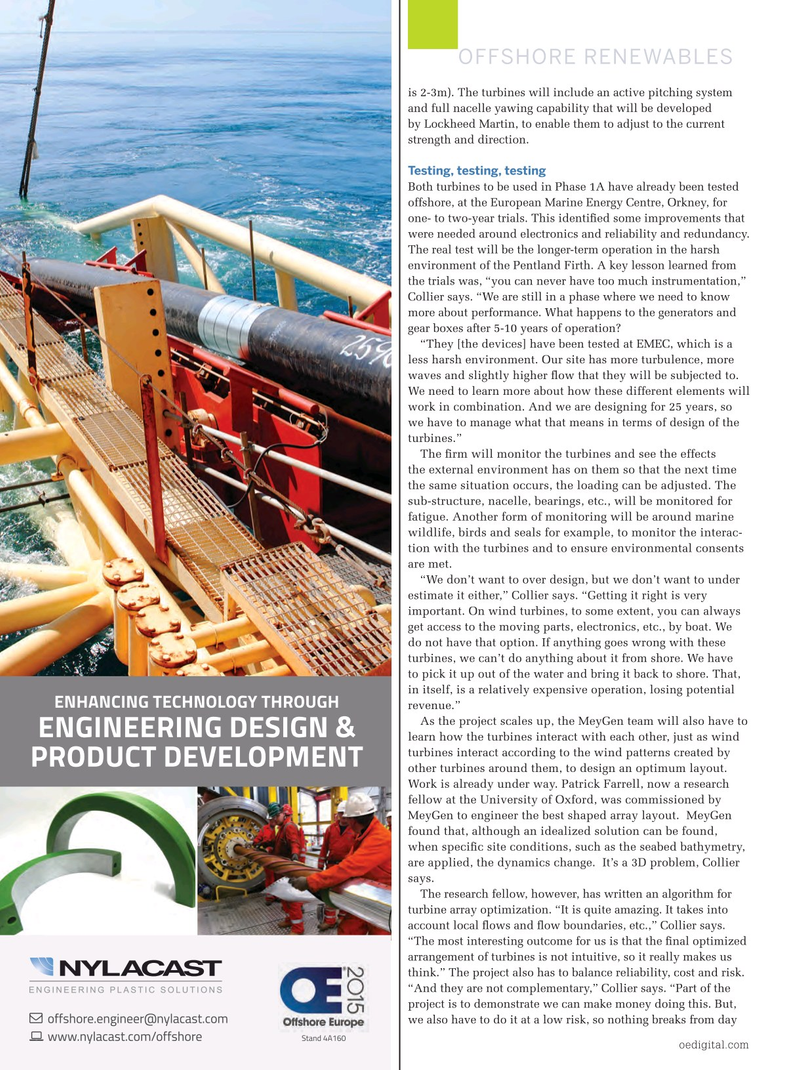
Page 26: of Offshore Engineer Magazine (Jun/Jul 2015)
Read this page in Pdf, Flash or Html5 edition of Jun/Jul 2015 Offshore Engineer Magazine
OFFSHORE RENEWABLES is 2-3m). The turbines will include an active pitching system and full nacelle yawing capability that will be developed by Lockheed Martin, to enable them to adjust to the current strength and direction.
one, to also prove it is
Testing, testing, testing reliable.”
Both turbines to be used in Phase 1A have already been tested Phase 1A will prove offshore, at the European Marine Energy Centre, Orkney, for the concept and reli- one- to two-year trials. This identifed some improvements that ability. Future steps for were needed around electronics and reliability and redundancy. the project will be about
The real test will be the longer-term operation in the harsh reducing costs. “We are environment of the Pentland Firth. A key lesson learned from always going to be look- the trials was, “you can never have too much instrumentation,” ing for cost reduction,”
Collier says. “We are still in a phase where we need to know Collier says. “Part of more about performance. What happens to the generators and that will be doing every- gear boxes after 5-10 years of operation? thing cheaper next time “They [the devices] have been tested at EMEC, which is a and fnding ways to get less harsh environment. Our site has more turbulence, more the cost of the turbine waves and slightly higher fow that they will be subjected to. down.”
We need to learn more about how these different elements will
As good as it could be work in combination. And we are designing for 25 years, so we have to manage what that means in terms of design of the So far, the project is turbines.” going as well as it could do, Collier says. “The nice thing about
The frm will monitor the turbines and see the effects what we have done, having been there from the start, is that we the external environment has on them so that the next time have the project design about right,” he says. “No one has said the same situation occurs, the loading can be adjusted. The we cannot do this or they want to change that. From a personal sub-structure, nacelle, bearings, etc., will be monitored for point of view, that’s pleasing. fatigue. Another form of monitoring will be around marine “We had a plan, and we said we were prepared to listen to wildlife, birds and seals for example, to monitor the interac- tion with the turbines and to ensure environmental consents are met. “We don’t want to over design, but we don’t want to under
JDR is your world-class estimate it either,” Collier says. “Getting it right is very partner for subsea power important. On wind turbines, to some extent, you can always get access to the moving parts, electronics, etc., by boat. We cables, production do not have that option. If anything goes wrong with these umbilicals, IWOC Systems turbines, we can’t do anything about it from shore. We have and Global Service support.
to pick it up out of the water and bring it back to shore. That, in itself, is a relatively expensive operation, losing potential
From design to delivery, we revenue.” engineer our products to ensure
As the project scales up, the MeyGen team will also have to safe and reliable deployment. To learn how the turbines interact with each other, just as wind build on that, we offer installation turbines interact according to the wind patterns created by and maintenance support other turbines around them, to design an optimum layout.
Work is already under way. Patrick Farrell, now a research throughout project planning, fellow at the University of Oxford, was commissioned by mobilisation, installation, repair,
Be sure to visit us at Brasil Offshore in Macaé
MeyGen to engineer the best shaped array layout. MeyGen planned maintenance and spares. to learn more about JDR products and services.
found that, although an idealized solution can be found,
JDR is totally committed to the when specifc site conditions, such as the seabed bathymetry, lifecycle of our products. We’re are applied, the dynamics change. It’s a 3D problem, Collier there every step of the way. says.
The research fellow, however, has written an algorithm for turbine array optimization. “It is quite amazing. It takes into account local fows and fow boundaries, etc.,” Collier says. “The most interesting outcome for us is that the fnal optimized @ConnectwithJDR • UNITED KINGDOM • SINGAPORE arrangement of turbines is not intuitive, so it really makes us • UNITED STATES • GERMANY /jdr-cable-systems think.” The project also has to balance reliability, cost and risk. • WEST AFRICA • BRASIL /ConnectwithJDR “And they are not complementary,” Collier says. “Part of the • THAILAND
WWW.JDRGLOBAL.COM project is to demonstrate we can make money doing this. But, we also have to do it at a low risk, so nothing breaks from day oedigital.com 026_OE0615_feat1_MayGen.indd 28 6/1/15 10:49 AM

 25
25

 27
27